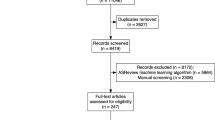Abstract
We investigated the prevalence and correlates of depressive symptoms in elementary school children in Jeju Island, Korea. The study participants were 2305 children enrolled in elementary schools in Jeju-si, Seogwipo-si, Namjeju-gun, and Bukjeju-gun and their parents who completed questionnaires about sociodemographics, health habits, family relationship information, and the Korean form of the Kovac’s children’s depression inventory (CDI) in September to December 2005. Multiple logistic regression showed that higher age (OR = 1.259, 95% CI 1.098–1.445), short time spent developing a relationship with the mother (OR = 2.770, 95% CI 1.280–5.944), and a low level of body image satisfaction (OR = 3.397, 95% CI 1.823–6.330) were correlates of depressive symptoms in children. Our results suggest that the following are essential to prevent depressive symptoms in elementary school children in Jeju, Korea: advanced education and social activity programs at home, in school, and in the community to help children have a positive self-image, and much time spent building a relationship with the mother.
Similar content being viewed by others
References
Chawla PL, Gupt K (1979) A comparative study of parents of emotionally disturbed and normal children. Br J Psychiatry 134:406–411
Cho SC, Lee YS (1990) Development of the Korean form of the Kovacs’ children’s depression inventory. J Korean Neuropsychiatr Assoc 29:943–956
Cicchetti D, Toth SL (1998) The development of depression in children and adolescents. Am Psychol 53:221–241
Costello EJ, Pine DS, Hammen C, March JS, Plotsky PM, Weissman MM, Biederman J, Goldsmith HH, Kaufman J, Lewinsohn PM, Hellander M, Hoagwood K, Koretz DS, Nelson CA, Leckman JF (2002) Development and natural history of mood disorders. Biol Psychiatry 52:529–542
Fleming JE, Offord DR (1990) Epidemiology of childhood depressive disorders. A critical review. J Am Acad Child Psychiatry 29:571–580
Friedman RJ, Butler LF (1979) Development and evaluation of a test battery to assess childhood depression. Final reports to health and welfare, project #606–1533-44 (unpublished manuscript). Ontario Institute for Studies in Education, Toronto
Green BJ (1980) Depression in early adolescence: an exploratory investigation of its frequency, intensity, and correlates. Dissert Abstrt Internatl 41:3890-B
Hill JL, Waldfogel J, Brooks-Gunn J, Han WJ (2005) Maternal employment and child development: a fresh look using newer methods. Dev Psychol 41:833–850
Hong KE (2005) Korean Textbook of Child Psychiatry. Joongangcopy, Seoul
Jang EJ, Seo MJ, Jeong CH (2001) The study of relation to variables related to children’s depression and parents’ depression. J Child Adolesc Psychiatry 12(2):245–255
Kang JH (1997) Assessment and management of obesity in primary care. J Korean Acad Family Med 18:882–896
Korea National Statistical Office (2005) Economically active population survey. Seoul. http://kosis.nso.go.kr/cgi-bin/sws_999.cgi
Korean Pediatric Association (1999) Standard height and body weight of Korean children and adolescents in 1998. Korea Pediatric Association, Seoul
Kovacs M (1983) A self-rated depression scale for school-aged youngsters. Unpublished manuscript, University of Pittsburgh School of Medicine
Kovacs M (1985) The children’s depression inventory. Psychopharmacy Bull 21:995–998
Last CG, Hansen C, Franco N (1997) Anxious children in adulthood: a prospective study of adjustment. J Am Acad Child Adolesc Psychiatry 36:645–652
Lee YS, Song DH (2005) Childhood mood disorder In: Textbook of neuropsychiatry 2nd edn. Choongangcopy, Seoul, p 583
Lewinsohn PM, Rohde P, Seeley JR, Klein DN, Gotlib IH (2000) Natural course of adolescent major depressive disorder in a community sample: predictors of recurrence in young adults. Am J Psychiatry 157:1584–1591
Li YP, Ma GS, Schouten EG, Hu XQ, Cui ZH, Wang D, Kok FJ (2007) Report on childhood obesity in China (5) body weight, body dissatisfaction, and depression symptoms of Chinese children aged 9–10 years. Biomed Environ Sci 20(1):11–18
Luby JL, Belden AC, Spitznagel E (2006) Risk factors for preschool depression: the mediating role of early stressful life events. J Child Psychol Psychiatry 47(12):1292–1298
McAdams DP (1989) Intimacy: the need to be close. Doubleday, New York
McCarty CA, McMahon RJ, Conduct Problems Prevention Research Group (2003) Mediators of the relation between maternal depressive symptoms and child internalizing and disruptive behavior disorders. J Fam Psychol 17:545–556
Park JA, Yang YS, Han JI, Kim SW, Hwang HS, Huh BY (1997) Weight in children’s minds : body shape dissatisfactions for 12-year old children. J Korean Acad Fam Med 18(6):622–631
Park JS, Choi YM, Lee JH (1995) Studies on factors involved in children’s depression—especially on home environment, rearing attitude, school achievement. J Korean Neuropsychiatr Assoc 34:1485–1491
Poznanaki EO, Krahenbuhl V, Zrull JP (1976) Childhood depression. A longitudinal perspective. J Am Acad Child Psychiatry 15:491–501
Scheidt P, Overpeck MC, Wyatt W, Aszmann A (2000) Adolescents’ general health and wellbeing. In: Setterbulte W (ed) Health and health behavior among young people. WHO policy series: health policy for children and adolescent, Issue 1. World Health Organization, Copenhagen, p 24–38
Shiner RL, Marmorstein NR (1998) Family environments of adolescents with lifetime depression: associations with maternal depression history. J Am Acad Child Adolesc Psychiatry 37:1152–1160
Thompson JK (1990) Body image disturbance. Assessment and treatment. Pergamon Press, New York
Turner HA, Butler MJ (2003) Direct and indirect effects of childhood adversity on depressive symptoms in young adults. J Youth Adolesc 32:89–103
Werkman SL, Greenberk ES (1967) Personality and interest patterns in obese adolescent girl. Psychosomatic Med 29:72–80
World Health Organization (1995) Physical status: the use and interpretation of anthropometry. WHO Technical Report Series. World Health Organization, Geneva
Author information
Authors and Affiliations
Corresponding author
Rights and permissions
About this article
Cite this article
Kwak, YS., Lee, CI., Hong, SC. et al. Depressive symptoms in elementary school children in Jeju Island, Korea: prevalence and correlates. Eur Child Adolesc Psychiatry 17, 343–351 (2008). https://doi.org/10.1007/s00787-008-0675-y
Accepted:
Published:
Issue Date:
DOI: https://doi.org/10.1007/s00787-008-0675-y




